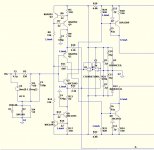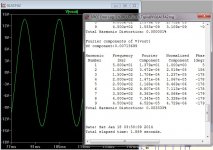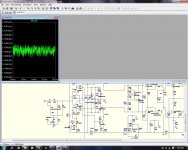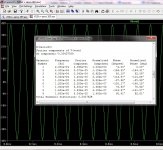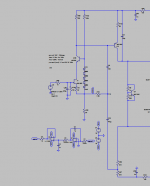Member
Joined 2009
Paid Member
Diamond buffer input stage + CMLC + beta enhanced VAS + 2 pole compensation + various output stages = Nice sounding amps.
I have had very nice results with
Singleton input stage + enhanced VAS + 2 pole compensation + output stage = nice sounding amp
Just replace the output stage with an ideal VCVS of gain 1 and you will note, for all practical purposes, a single pole (from the VAS) for both the CFA and the LTP VFA.
This is darn close to what I have done with my TGM7 since it is an amplifier where the VAS is the output stage. And it has both CFA and VFA configurations.
Mr. Cordell has this outstanding capacity of telling the truth without making it sound offensive for the contenders.
In each and every imaginable configuration, the VFA LTP input stage pole is in the tenths or even hundreds of MHz. This is what also jcx, Mr. Zan, yours truly and others repeated ad nauseum. The effect that Bonsai is reporting (of CFAs having the open loop OPS pole pushed towards higher frequencies) has another explanation: the HF VAS output impedance can be lower for the CFA, compared to a standard VFA. This doesn't mean it can't be made the other way around, if that would really be critical (which is not).
Just replace the output stage with an ideal VCVS of gain 1 and you will note, for all practical purposes, a single pole (from the VAS) for both the CFA and the LTP VFA.
Example is attached, you can clearly see the input stage VFA pole far away at about 50MHz or so. The example is run on Bonsai schematics, no compensation was used.
EDIT1: Added the schematics, for clarity.
EDIT2: Open loop phase also added. As expected, the VFA LTP pole causes the open loop phase to gap at over 50MHz. Is it now clear that the VFA LTP pole has virtually no impact?
Thank you Waly for your kind words.
Cheers,
Bob
Please, Waly, if you want to explore and compare, use something more fairly comparable.
You can play with my files: Same open loop gain, same closed loop gain, same VAS, same OPS.
http://www.esperado.fr/temp/compare_vssa/closed-loop-bandwidth.gif
As the only difference is the input stage, can you say it has no influence ?
Yes, Mr Cordel has the outstanding capacity to be both serious, competent, open minded and more than polite and respectful to his interlocutors: nice and friendly.
Thank you also, Esperado, for your kind words.
Cheers,
Bob
Just an observation over time... I guess it was repeated many times and in many ways -- what? That when ever there was an advantage or a difference displayed, the VFA (or CFA) camp figures they can match it if they just change this and that around..... Over and over here to the point where my brain said - "I've heard this pattern before".
In the beginning of this, we wanted to know what a CFA was... the pro-con and configuration which gives it the pro's and con's. Now the two have been tweaked to become so much alike that there is almost no difference between them.
Its just something I noticed throughout this thread: The competitive back and forth has produced potential matching solutions to just about everything which had traditionally made VFA and CFA more different out in the field/market place. Hmmmm. Strange.
Still doesnt answer why so many companies and people hear and like CFA best. But, then if more VFA were made as descibed here, the gap might actually be almost nil.
Except for that pesky input stage.
Thx-RNMarsh
In the beginning of this, we wanted to know what a CFA was... the pro-con and configuration which gives it the pro's and con's. Now the two have been tweaked to become so much alike that there is almost no difference between them.
Its just something I noticed throughout this thread: The competitive back and forth has produced potential matching solutions to just about everything which had traditionally made VFA and CFA more different out in the field/market place. Hmmmm. Strange.
Still doesnt answer why so many companies and people hear and like CFA best. But, then if more VFA were made as descibed here, the gap might actually be almost nil.
Except for that pesky input stage.
Thx-RNMarsh
Last edited:
Just an observation over time... I guess it was repeated many times and in many ways -- what? That when ever there was an advantage or a difference displayed, the VFA (or CFA) camp figures they can match it if they just change this and that around..... Over and over here to the point where my brain said - "I've heard this pattern before".
In the beginning of this, we wanted to know what a CFA was... the pro-con and configuration which gives it the pro's and con's. Now the two have been tweaked to become so much alike that there is almost no difference between them.
Its just something I noticed throughout this thread: The competitive back and forth has produced potential matching solutions to just about everything which had traditionally made VFA and CFA more different out in the field/market place. Hmmmm. Strange.
Still doesnt answer why so many companies and people hear and like CFA best. But, then if more VFA were made as descibed here, the gap might actually be almost nil.
Except for that pesky input stage.
Thx-RNMarsh
I'm curious too...
Many person who hear my amps, VFA and CFA, they notice the different. They like CFA than VFA and they do not know about electronics. Usually they comment when hear my CFA, " hey, the cymbal is so real..."
Last edited:
CFA .... VFA
Both can be made to be the same .
Just made another CFA "breakthrough".....
Miib's idea of using servo FB to bias the CCS's has another "side effect" !
(below) I simplified the technique letting the servo error voltage bias
the "center point" of the 2 opposing CCS's.
Not only do I get 2-5nV ! offset ... even over 40C thermals , but I can
even swap the KSA input tranny with a MJE - still 5nV.
The unexpected thing was another 10db of LF PSRR reduction. This "bombed out"
simple little thing can even beat some of my VFA's (PSRR) now !
Not at all "bloated" , with only 8 semi's/1 cheap IC .... 20-35ppm 20-20k .
.
A "happy" little circuit - seems devoid of "bad habits" ..
I like this one better than my first one .. actually.
PS- I have an "opposing" VFA (9 semi's) push pull VAS , CCS, single LTP ..
120+ V/us - same 53db OLG /20-30PPM (symasym like).
OS
Both can be made to be the same .
Just made another CFA "breakthrough".....
Miib's idea of using servo FB to bias the CCS's has another "side effect" !
(below) I simplified the technique letting the servo error voltage bias
the "center point" of the 2 opposing CCS's.
Not only do I get 2-5nV ! offset ... even over 40C thermals , but I can
even swap the KSA input tranny with a MJE - still 5nV.
The unexpected thing was another 10db of LF PSRR reduction. This "bombed out"
simple little thing can even beat some of my VFA's (PSRR) now !
Not at all "bloated" , with only 8 semi's/1 cheap IC .... 20-35ppm 20-20k
A "happy" little circuit - seems devoid of "bad habits" ..
I like this one better than my first one .. actually.
PS- I have an "opposing" VFA (9 semi's) push pull VAS , CCS, single LTP ..
120+ V/us - same 53db OLG /20-30PPM (symasym like).
OS
Attachments
CFA .... VFA
Both can be made to be the same .
Just made another CFA "breakthrough".....
Miib's idea of using servo FB to bias the CCS's has another "side effect" !
(below) I simplified the technique letting the servo error voltage bias
the "center point" of the 2 opposing CCS's.
Not only do I get 2-5nV ! offset ... even over 40C thermals , but I can
even swap the KSA input tranny with a MJE - still 5nV.
The unexpected thing was another 10db of LF PSRR reduction. This "bombed out"
simple little thing can even beat some of my VFA's (PSRR) now !
Not at all "bloated" , with only 8 semi's/1 cheap IC .... 20-35ppm 20-20k.
A "happy" little circuit - seems devoid of "bad habits" ..
I like this one better than my first one .. actually.
PS- I have an "opposing" VFA (9 semi's) push pull VAS , CCS, single LTP ..
120+ V/us - same 53db OLG /20-30PPM (symasym like).
OS
Thank you, OS. I sim your servo on my CFA. It work, but I already sent my drawing to PCB maker.
Measure the 50Hz THD? I found the single opamp servo not slow enough to counter the wave form envelope distortion (the servo drifting on slow input signals). I'm divided on using them because of it.
5Hz - 50hz/ 5k -50K nothing changes ... I HATE chips in my amps !
But , this is a good use ...
BTW- I Researched OEM servo integrator values for R/C before connecting the servo. My 32 YO sansui's servo uses 1u / 470k ....
PS- 10 -100hz blocking capacitor induced distortion was my reason to use
a stupid chip in the first place.
Edit (below 2) is static offset (no signal) ...
OS
Attachments
Last edited:
Just an observation over time... That when ever there was a...difference displayed, the VFA (or CFA) camp ...can match it ...become so much alike that there is almost no difference between them
Not odd at all.
The feedback conservation laws are identical for both, the physics and devices the same, and so on.
So of course the results should be essentially identical.
This is what the wiser posts have stated from the start.
That any "?FA is SO superior" statements are just "fan-boy" noise.
You imply that the persistent of belief in CFA proves that there must be element of truth in the difference.
Probably not, people have persistently believed in Zeus, Thor, Voodoo, witches, spells, snake oil etc etc.
Best wishes
David
Thank you, OS. I sim your servo on my CFA. It work, but I already sent my drawing to PCB maker.
This is the result....
Attachments
Diamonds are a girls's best friend.
Where are the girls ? I only see a river of diamonds here.
Where are the girls ? I only see a river of diamonds here.
Girls are actually the boys here who are in love with the diamonds.
Men don't need them.
Still doesnt answer why so many companies and people hear and like CFA best.
CFA-s are simply better for power amps, BTW try to ask Accuphase guys, they know for sure.

I'm curious too...
Many person who hear my amps, VFA and CFA, they notice the different. They like CFA than VFA and they do not know about electronics. Usually they comment when hear my CFA, " hey, the cymbal is so real..."
Here on the other side of the world same situation.
Diamonds are really good.. simply the best material for bass-membranes. I fail to see the benefit of the input diamond in a CFA amplifier, unless it's for making the input-filter independent of the the series resistance of the source. (as in having an unbuffered volume control in front of the amplifier)
I fail to see the benefit of the input diamond in a CFA amplifier, unless it's for making the input-filter independent of the the series resistance of the source. (as in having an unbuffered volume control in front of the amplifier)
I have had very nice results with
Singleton input stage + enhanced VAS + 2 pole compensation + output stage = nice sounding amp
He He,
Tempted to try this formula. At present I'm building variations on strip board to compare results. Probably have enough parts in stock already to do it. What's the advantage of the singleton input?
Lazy not talking about the source output, but if you attach a passive volume control in front of yours/my circuit, then the typical 1K/330pF input filter roll-off varies a lot with the volume setting. If you look at how Sonny's input diamond the makes the input filter integrated in a very clever way. This is a true practical benefit of the diamond input.
- Home
- Amplifiers
- Solid State
- CFA Topology Audio Amplifiers
